Modern Tunneling Design Methods
DOI:
https://doi.org/10.14195/2184-8394_16_1Abstract
The author gives a short analysis of modem tunneling procedures, specially of the experimental, laboratory ones.
Given the need for a deep knowledge of the mechanical behaviour of rock masses, the actual state of knowledge of the fundamental parameters envolved has been first reviewed.
Based on the continuum, plain strain, elastic-plastic approach, a classical analytical study of a circular tunnel through ground reaction curves is presented next, in order to visualize the importance of the mechanical properties of the rock mass, of the tunnel geometry and of the internal stresses, in the stability of the excavation and the eventual need for a lining. According to the recent European approaches, the study of the lining itself and of the tunnel face has also been presented. The adequacy of these aproaches was apraised and the need for monitoring was stressed, especially during construction.
Finally, the author describes six model studies on tunnel behaviour, four of unlined tunnels and two of lined tunnels, five of them based on a bibliographic analysis and the other developed for the Cabora Bassa undertaking by the Laboratório Nacional de Engenharia Civil.




